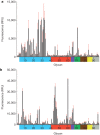Pathogenesis and transmission of avian influenza A (H7N9) virus in ferrets and mice
- PMID: 23842497
- PMCID: PMC7094885
- DOI: 10.1038/nature12391
Pathogenesis and transmission of avian influenza A (H7N9) virus in ferrets and mice
Abstract
On 29 March 2013, the Chinese Center for Disease Control and Prevention confirmed the first reported case of human infection with an avian influenza A(H7N9) virus. The recent human infections with H7N9 virus, totalling over 130 cases with 39 fatalities to date, have been characterized by severe pulmonary disease and acute respiratory distress syndrome (ARDS). This is concerning because H7 viruses have typically been associated with ocular disease in humans, rather than severe respiratory disease. This recent outbreak underscores the need to better understand the pathogenesis and transmission of these viruses in mammals. Here we assess the ability of A/Anhui/1/2013 and A/Shanghai/1/2013 (H7N9) viruses, isolated from fatal human cases, to cause disease in mice and ferrets and to transmit to naive animals. Both H7N9 viruses replicated to higher titre in human airway epithelial cells and in the respiratory tract of ferrets compared to a seasonal H3N2 virus. Moreover, the H7N9 viruses showed greater infectivity and lethality in mice compared to genetically related H7N9 and H9N2 viruses. The H7N9 viruses were readily transmitted to naive ferrets through direct contact but, unlike the seasonal H3N2 virus, did not transmit readily by respiratory droplets. The lack of efficient respiratory droplet transmission was corroborated by low receptor-binding specificity for human-like α2,6-linked sialosides. Our results indicate that H7N9 viruses have the capacity for efficient replication in mammals and human airway cells and highlight the need for continued public health surveillance of this emerging virus.
Conflict of interest statement
The authors declare no competing financial interests.
Figures


References
-
- WHO. Avian influenza A(H7N9) virushttp://www.who.int/influenza/human_animal_interface/influenza_h7n9/en/in... (2013)
Publication types
MeSH terms
Substances
Grants and funding
LinkOut - more resources
Full Text Sources
Other Literature Sources

